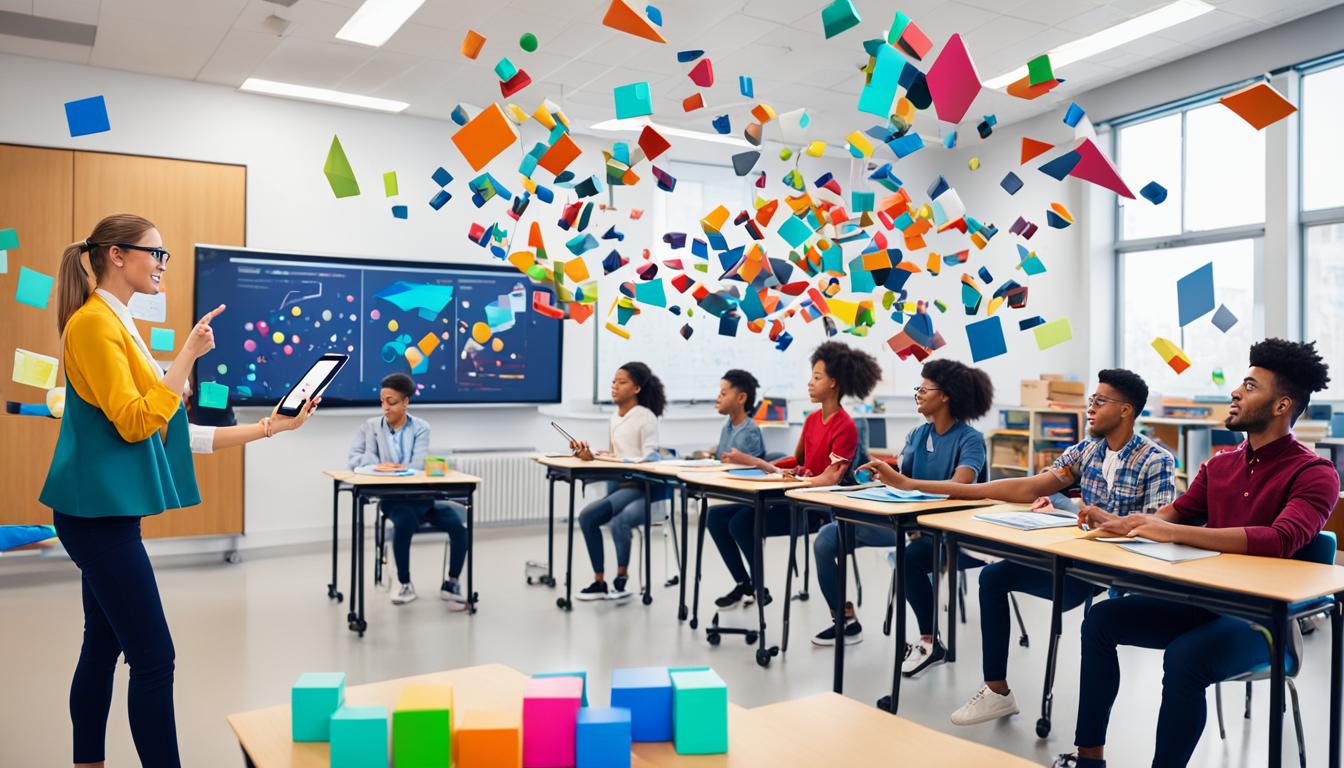Welcome to our comprehensive guide on how to use augmented reality (AR) in the classroom. Augmented reality offers exciting opportunities for educators to create immersive learning experiences and enhance student engagement. By integrating AR into the curriculum, teachers can revolutionize the way students interact with course content and the world around them. In this guide, we will explore the benefits of augmented reality in education, provide practical tips on incorporating AR into the classroom, and highlight some popular AR apps for education.
AR technology combines real and virtual objects, aligns them in a seamless manner, and allows for real-time interaction. Its accessibility through smartphones and tablets has made it a popular choice in education. AR engages students in new and dynamic ways, making the learning process more interactive and impactful. By integrating AR applications into various classroom activities such as scavenger hunts, technical skills development, field trips, and labs, educators can create engaging, innovative, and immersive learning experiences for their students.
Throughout this guide, we will delve into the benefits of augmented reality in learning. We will explore how AR enhances student learning, boosts outcomes, and promotes interactivity and collaboration. Additionally, we will highlight practical strategies for incorporating AR into the classroom, including preparation, selecting appropriate AR tools, and designing an AR classroom environment that complements traditional teaching methods.
To get you started on your AR journey, we will also showcase some popular augmented reality apps for education. These apps cater to different subjects and age groups, providing versatile tools for educators to leverage in their teaching practices. Whether you’re a seasoned AR enthusiast or just starting out, this guide will equip you with the knowledge and resources to effectively integrate augmented reality into your classroom.
Contents
- 1 What is Augmented Reality and Why Should I Teach with AR?
- 2 How to Incorporate AR into the Classroom
- 3 Benefits of Augmented Reality in Education
- 4 Augmented Reality Apps for Education
- 5 Designing an Augmented Classroom
- 6 Lesson Ideas for Augmented Reality in Education
- 7 Conclusion
- 8 FAQ
- 8.1 How can I use augmented reality in the classroom?
- 8.2 What is augmented reality and why should I teach with it?
- 8.3 How do I incorporate AR into the classroom?
- 8.4 What are the benefits of augmented reality in education?
- 8.5 Are there augmented reality apps for education?
- 8.6 How should I design my classroom to incorporate augmented reality?
- 8.7 What are some lesson ideas for augmented reality in education?
- 8.8 What is the conclusion regarding augmented reality in the classroom?
- 9 Source Links
Key Takeaways:
- Augmented reality (AR) offers dynamic ways for students to engage with course content and the world around them.
- AR technology combines real and virtual objects, allowing for interactive, immersive learning experiences.
- Integrating AR into the classroom enhances student learning, engagement, and outcomes in various aspects of training.
- AR applications can be incorporated into scavenger hunts, technical skills development, field trips, and labs.
- Popular AR apps for education cater to different subjects and age groups, providing versatile tools for educators.
What is Augmented Reality and Why Should I Teach with AR?
Augmented reality (AR) is a technology that adds a digital overlay to the real world, combining real and virtual objects and allowing for real-time interaction. Unlike virtual reality (VR), which creates a completely virtual experience, AR enhances the real world with virtual elements. AR engages students in new and dynamic ways by providing more information and visualization to the real world. It enhances learning by allowing students to explore and visualize concepts in ways that are not possible with traditional methods. AR increases student engagement, motivation, and interest in studying. It boosts outcomes in various aspects of training, including professional knowledge, cognitive and practical skills, social skills, innovation, competence, and creativity.
Augmented reality enhances the real world with virtual elements and engages students in dynamic ways, boosting their motivation and learning outcomes. It offers a wide range of benefits for educators and students alike.
By integrating augmented reality into your teaching practices, you can create immersive learning experiences that captivate and inspire your students. AR allows them to interact with the subject matter in a hands-on and visual way, making abstract concepts more tangible and accessible. This technology ignites curiosity, fosters creativity, and encourages collaboration among students.
The importance of AR in education cannot be overstated. It transforms the learning process by breaking traditional barriers and opening new avenues for exploration. With AR, students can delve deeper into complex topics, visualize three-dimensional models, and gain a deeper understanding of the subject matter.
- AR enhances learning by providing visual representations of abstract concepts.
- AR promotes active learning and student engagement.
- AR improves knowledge retention and recall.
- AR fosters collaboration and social interaction among students.
- AR boosts students’ problem-solving and critical-thinking skills.
Augmented reality is a powerful tool that has the potential to revolutionize the way we teach and learn. Its benefits extend beyond the classroom, preparing students for the increasingly digital world they will enter.
How to Incorporate AR into the Classroom
Incorporating augmented reality (AR) into the classroom requires careful preparation and an understanding of the potential AR brings to education. With the right approach, AR can revolutionize classroom learning and engage students in new and dynamic ways. Here are some key strategies to effectively incorporate AR into your teaching:
Create Engaging AR Experiences with Applications
Start by exploring various AR applications that can enhance your lessons. Popular AR apps such as Aurasma and Visible Body’s Human Anatomy Atlas offer ready-made resources that can be used or customized to create interactive AR experiences. These applications allow you to bring concepts to life and provide students with hands-on learning opportunities.
Prepare Students for AR Activities
Before diving into AR activities, it’s essential to provide students with the necessary preparation. Begin by giving them an overview of the material that will be covered and explain how AR technology works. You can also model how to use AR technology effectively. Setting clear tasks or goals for students to accomplish during AR activities will help them stay focused and engaged.
Gamify the Classroom with AR
AR offers a fantastic opportunity to gamify your classroom. By incorporating game elements into your lessons, you can increase student motivation and make learning more enjoyable. Create AR-based scavenger hunts or quizzes that require students to explore their surroundings and find hidden digital objects. This gamified approach encourages active participation and knowledge retention.
Develop Specific Technical Skills with AR
AR is not just limited to enhancing theoretical concepts; it can also foster the development of specific technical skills. For example, you can use AR applications to teach coding, graphic design, or architecture. These hands-on experiences with AR technology can be invaluable for students looking to pursue careers in technical fields.
Enhance Field Trips and Labs
AR can transform field trips and lab experiences, making them more immersive and interactive. Instead of traditional field trip guides or lab manuals, students can use AR apps to explore historical sites or conduct virtual experiments. This technology allows for enhanced experiences while minimizing the setup and cleanup required for traditional hands-on activities.
By incorporating AR into your classroom, you can create an engaging and interactive learning environment that captivates students and enhances their understanding of complex concepts.
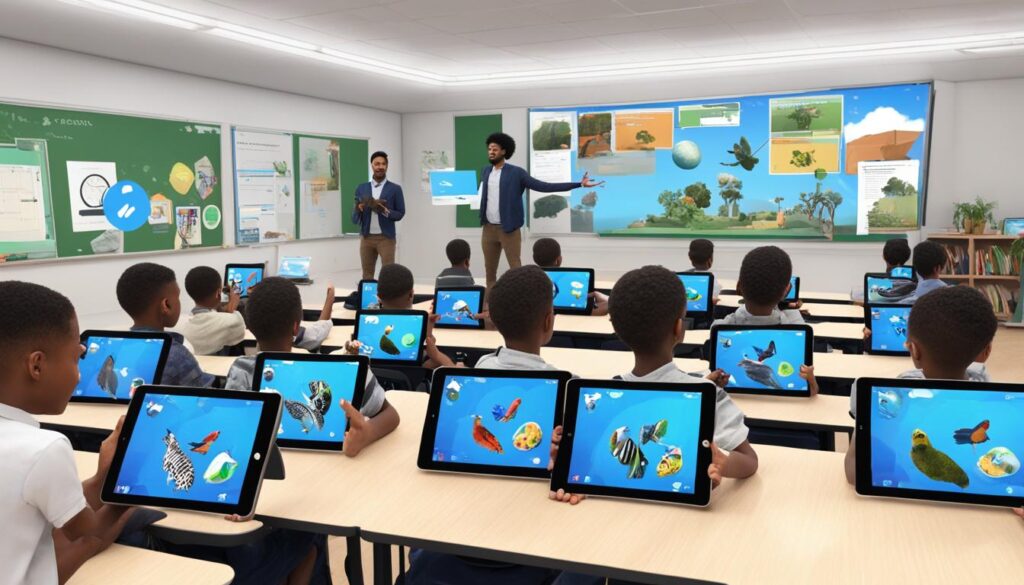
| Application | Subject | Age Group |
|---|---|---|
| Popar Toys | Various Subjects | All Ages |
| Augment Education | Various Subjects | All Ages |
| SkyMap | Science | All Ages |
| Fetch Lunch Rush | Math | All Ages |
| Human Anatomy Atlas | Science | All Ages |
Benefits of Augmented Reality in Education
Augmented reality (AR) in education offers a multitude of benefits that enhance the learning experience for students. By incorporating AR technology into the classroom, educators can tap into its potential to foster engagement, motivation, interactivity, collaboration, and overall learning gains.
Boosts Engagement and Motivation
AR captivates students by providing interactive experiences with coursework. Through movement and lifelike exploration, AR engages students’ senses, making the learning process dynamic and immersive. By bridging the gap between the real and the virtual, AR creates a stimulating and exciting environment that motivates students to actively participate in their learning journey.
Enhances Learning Gains
AR allows students to visualize and experiment with abstract concepts. It brings static information to life by revealing hidden layers and systems, enabling students to gain a deeper understanding of complex subjects. With AR, students can experience firsthand what they are learning, building a solid foundation of knowledge and acquiring practical skills through interactive simulations and visual representations.
Promotes Interactivity and Collaboration
AR promotes collaboration among students as they engage in shared experiences and work together to solve problems and achieve common goals. Through AR applications and activities, students can collaborate on projects, participate in virtual simulations, and interact with virtual objects in a collaborative setting. This fosters teamwork, communication, and critical thinking skills, preparing students for future workplace environments that value collaboration and cooperation.
AR enhances traditional curricula by providing a holistic view of subject matter, offering diverse resources that may not be accessible otherwise, and challenging students to explore and apply their knowledge in innovative ways.
| Benefits | Description |
|---|---|
| Engagement and Motivation | AR boosts student engagement and motivation by providing interactive and captivating learning experiences. |
| Learning Gains | AR enhances learning gains by allowing students to visualize and experiment with abstract concepts, resulting in deeper understanding and practical skill acquisition. |
| Interactivity and Collaboration | AR promotes interactivity and collaboration among students, fostering teamwork, communication, and critical thinking skills. |
AR in education opens doors to a new era of immersive and effective learning, where students actively engage with the material, collaborate with their peers, and develop essential skills for success in the 21st century.
Augmented Reality Apps for Education
Augmented reality (AR) technology has revolutionized education, providing students with immersive learning experiences. There is a wide range of AR apps available for education, catering to different subjects and age groups. These apps offer interactive and engaging content that enhances student understanding and retention.
Popular AR Apps for Education
Let’s explore some popular AR apps that are widely used in classrooms:
| App Name | Subject | Age Group |
|---|---|---|
| Popar Toys | Various subjects | All ages |
| Augment Education | Science, Math, Engineering | Middle to High School |
| SkyMap | Astronomy | All ages |
| Fetch Lunch Rush | Math, Problem-solving | Elementary School |
| Human Anatomy Atlas | Biology, Anatomy | High School, College |
These apps offer a range of features, allowing students to:
- Interact with stories in a more engaging way
- Create dynamic presentations
- Explore the solar system and astronomical objects
- Solve math problems with visual aids
- Express their creativity through storytelling
- Study and visualize the human anatomy
These versatile AR apps provide educators with valuable tools to enhance their teaching methods and engage students effectively.
Whether it’s bringing historical artifacts to life, measuring objects in math class, or exploring the intricacies of the human body, augmented reality apps offer endless possibilities for engaging and interactive education.
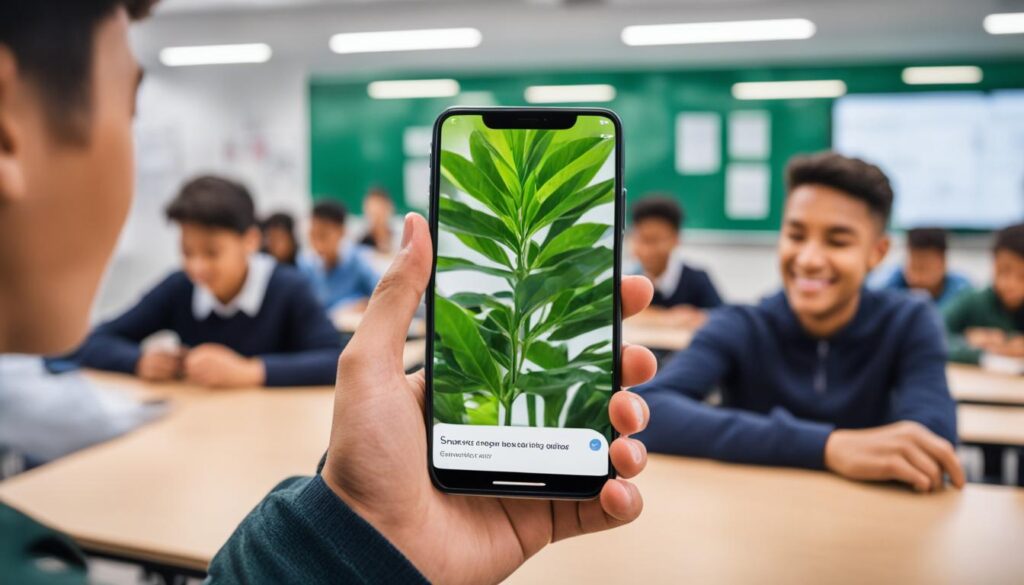
By utilizing popular AR apps for different subjects and age groups, teachers can create dynamic learning experiences that captivate students and deepen their understanding of the curriculum.
Designing an Augmented Classroom
When integrating augmented reality (AR) technology into the classroom, it is essential for teachers to design the classroom environment with AR in mind. By considering the following factors, you can create an optimal AR learning space:
- Integrating AR as a supplementary tool: AR should be used to enhance traditional lessons, rather than replacing them entirely. It serves as a supplementary tool that complements other methods of delivering content. By integrating AR strategically, you can offer students a unique and engaging learning experience.
- Knowing the technological competence of students: Before incorporating AR into your lessons, it is important to assess the technological competence of your students. Ensure that they possess the necessary skills to effectively navigate and interact with AR technology. If students lack the required technological know-how, it may hinder the implementation of AR in the classroom.
By adopting these considerations, you can design an augmented classroom that optimizes the use of AR as a supplementary tool for enhancing student learning.
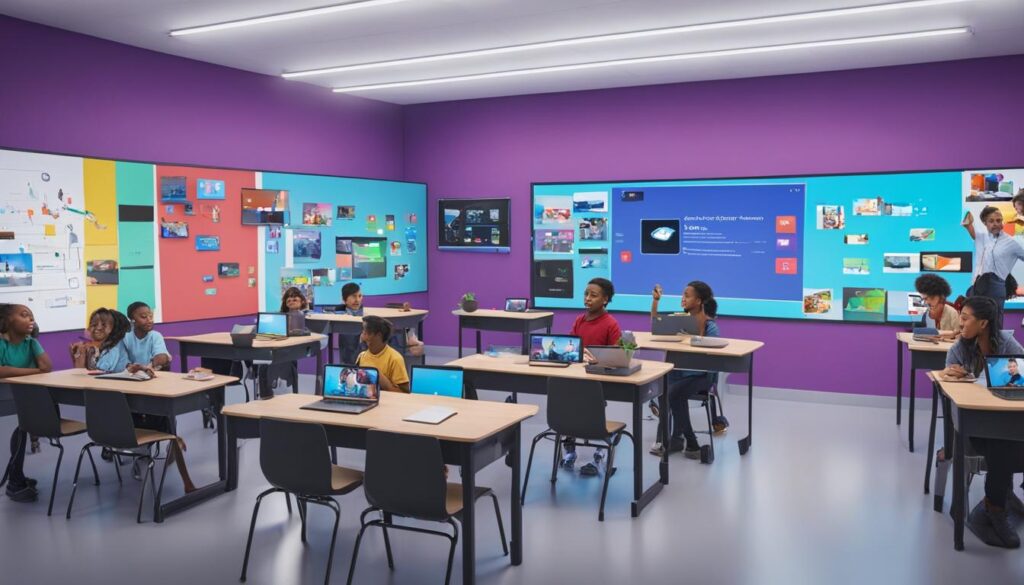
| Classroom Element | Description |
|---|---|
| AR Display Stations | Strategic placement of multiple AR display stations throughout the classroom provides students with easy access to AR experiences and enhances collaborative learning. |
| Flexible Seating Arrangement | Arranging desks and chairs in a way that allows students to comfortably engage with AR activities, ensuring that classroom furniture does not obstruct the AR experience. |
| Interactive Projector | Utilizing an interactive projector to display AR content on a large scale, enabling whole-class participation and fostering a collaborative learning environment. |
| AR Resource Library | Creating a dedicated space within the classroom to store AR resources, such as books, markers, and manipulatives, promoting easy accessibility for students. |
Quote: “Designing an augmented classroom requires thoughtful consideration of both the technological aspects of AR and the physical environment. By integrating AR as a supplementary tool and understanding the technological competence of students, educators can create an immersive learning environment that enhances student engagement and learning outcomes.” – Dr. Sarah Johnson, Educational Technologist
Lesson Ideas for Augmented Reality in Education
Augmented reality (AR) offers a range of exciting lesson ideas for different subjects. By incorporating AR into your classroom, you can create immersive learning experiences that captivate and engage your students. Here are some AR lesson ideas for history, math, literacy and literature, and science:
History
- Use the Civilisations AR app to bring historical artifacts to life in your classroom. Students can explore ancient artifacts and monuments through their devices, making history more interactive and engaging.
Math
- Introduce the Measure app to your students, allowing them to measure objects and explore their environment in a new and fun way. Students can develop their spatial reasoning skills while enjoying hands-on learning.
Literacy and Literature
- Bring storytelling to life with the AR Makr app. Students can create their own drawings and animations, then use AR to transform their creations into interactive stories. This activity promotes creativity and enhances literacy skills.
Science
- Engage students in the study of biology and ecosystems with apps like Froggipedia and WWF Free Rivers. These apps provide immersive experiences that allow students to explore the frog life cycle and learn about different ecosystems in an interactive and informative way.
By incorporating these AR lesson ideas into your teaching, you can leverage technology to enhance student learning and make subjects come alive. AR provides a unique opportunity to engage students in a way that traditional methods cannot achieve, creating memorable learning experiences.
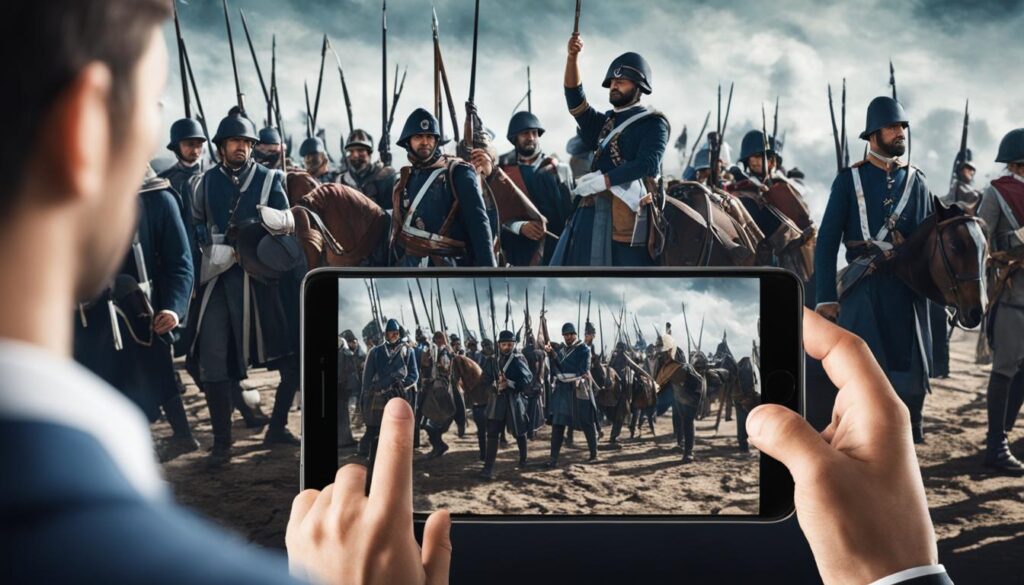
| Subject | AR App | Description |
|---|---|---|
| History | Civilisations AR | Brings historical artifacts into the classroom for an interactive exploration of history. |
| Math | Measure app | Allows students to measure objects and explore their environment in a new and fun way. |
| Literacy and Literature | AR Makr | Enables students to bring their creativity and drawings into an interactive setting for storytelling. |
| Science | Froggipedia | Provides an immersive experience to explore the frog life cycle and study biology. |
| Science | WWF Free Rivers | Allows students to learn about ecosystems and the impact of human activities on rivers. |
Conclusion
Augmented reality (AR) is a rapidly advancing technology that holds immense potential for enhancing learning experiences in the classroom. By integrating AR into their teaching practices, educators can engage students on a whole new level, boosting motivation, promoting collaborative learning, and facilitating interactive exploration.
One of the key advantages of AR is its accessibility. With the widespread availability of smartphones and tablets, AR technology is more accessible than ever before, allowing students to easily engage with virtual content and interact with their real-world surroundings. This accessibility opens up a world of opportunities for educators to incorporate AR into their curriculum.
AR offers numerous benefits in the classroom. It enriches learning by providing additional information and visualizations, making abstract concepts more tangible and engaging. It also fosters collaboration among students, encouraging them to work together, solve problems, and explore ideas collectively. Furthermore, AR increases student motivation, as the immersive and interactive nature of AR experiences taps into their natural curiosity and desire to learn.
In conclusion, AR technology has revolutionized the way we approach education. By leveraging the power of AR, educators can captivate and inspire students, create dynamic and immersive learning environments, and enhance learning outcomes. With its accessibility and myriad of benefits, AR is undoubtedly a valuable tool for modern classrooms, empowering both students and teachers to embrace a new era of educational possibilities.
FAQ
How can I use augmented reality in the classroom?
Augmented reality can be incorporated into the classroom by using AR applications, preparing students for AR activities, and integrating AR into various classroom activities such as scavenger hunts, technical skills development, field trips, and labs.
What is augmented reality and why should I teach with it?
Augmented reality enhances the real world with virtual elements, engaging students in new and dynamic ways. Teaching with AR allows for more visualization and exploration of concepts, increases student engagement and motivation, and boosts learning outcomes.
How do I incorporate AR into the classroom?
To incorporate augmented reality into the classroom, teachers should familiarize themselves with AR applications, provide an overview of the material, model how to use AR technology, and give students tasks or goals to accomplish during AR activities. AR can be used to gamify the classroom, develop technical skills, enhance field trips, and conduct labs.
What are the benefits of augmented reality in education?
Augmented reality in education promotes interactive experiences with coursework, encourages collaboration, improves motivation, and increases learning gains. It engages students through movement and lifelike exploration, visualizes abstract concepts, allows for deeper learning, provides a holistic view, and offers resources that may not be available otherwise.
Are there augmented reality apps for education?
Yes, there are numerous augmented reality apps available for education. Popular AR apps include Popar Toys, Augment Education, SkyMap, Fetch Lunch Rush, and Human Anatomy Atlas. These apps cater to different subjects and age groups, making them versatile tools for educators.
How should I design my classroom to incorporate augmented reality?
When incorporating augmented reality into the classroom, teachers should design the environment with AR in mind. AR should be used as a supplementary tool, enhancing traditional lessons. Teachers should also assess the technological competence of their students to ensure AR is suitable for their classroom.
What are some lesson ideas for augmented reality in education?
In history, teachers can use apps like Civilisations AR to bring historical artifacts into the classroom. In math, the Measure app allows students to measure objects and explore their environment. AR Makr can be used in literacy and literature to let students bring their creativity and drawings into an interactive storytelling setting. In science, apps like Froggipedia and WWF Free Rivers provide immersive experiences for studying biology and ecosystems.
What is the conclusion regarding augmented reality in the classroom?
Augmented reality offers various benefits in the classroom, including increased engagement, enhanced learning, and improved motivation. With the accessibility of AR technology through smartphones and tablets, educators can use AR to engage students, reinforce information, and promote dynamic and immersive learning experiences.

